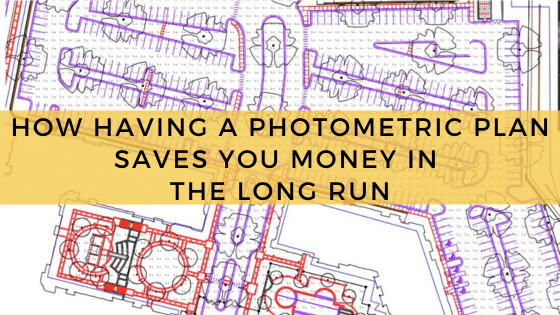
Photometric plans save property owners money on every lighting project. Photometric plans save money because they:
- Ensure the project meets the client’s needs perfectly, the first time
- Optimize the lighting system’s energy efficiency
- Avoid light pollution by observing dark sky regulations
- Minimize the risk of costly mistakes or change orders
Together, these benefits boost the immediate and long-term savings for a variety of commercial projects. We will take a closer look at each of those benefits and how they can improve your lighting project’s cost efficiency.
What is a Photometric Plan and What are its Benefits?
Photometric plans are an important tool that lighting designers use to develop a lighting project before it is installed. In the hands of an experienced designer, photometric plans provide several advantages to every project. Specifically, a photometric plan can help with the following lighting solutions:
- Sports arenas, including tennis and pickleball courts
- Municipal parks and public areas
- Parking lots and garages
- Commercial retail centers
- Department stores
- Warehouses
In short, photometric plans make sense for any commercial space, regardless of location or layout, as they offer the following benefits:
- Better lighting coverage
- Better lighting quality and performance
- Reduced glare, light trespass and lighting pollution
- Observation of dark sky regulations
- Reduced planning and installation time
These benefits are in addition to the cost savings that photometric plans offer, which we will address in detail next.
1) Photometric Plans Guarantee Optimal Lighting Coverage
Photometric plans simulate lighting solutions with excellent precision, and an experienced design team can use it with properties of any size, layout or purpose without compromising this precision.
For the purposes of lighting a property, precision really means “do your lights provide illumination where it’s needed, and only where it’s needed?” By optimizing the system’s coverage and distribution patterns, photometric plans ensure clients get the most useful light for every dollar spent and that the light is only dispersed where it is needed, reducing light pollution.
For example, commercial parking lots must meet minimum lighting levels to maintain safety and attract customers. The Illuminating Engineering Society (IES) has even published recommendations for parking lot owners for this purpose (between one- and four-foot candles throughout the lot). Photometric planning allows lighting designers to take those recommendations and apply them before a single fixture, driver or luminaire is placed. The result is optimal lighting performance without using more fixtures than needed.
2) A Photometric Plan Maximizes Energy Efficiency
Photometric plans ensure improved energy efficiency, which saves businesses money in the long run. According to the Department of Energy, commercial properties can save thousands every year in utilities by switching to high-efficiency lighting like LEDs.
Photometric planning can further this energy efficiency mission by optimizing every fixture’s placement. As mentioned, this has significant performance benefits, which means property owners get more value from their new lights.
Optimal lighting placement also means your property will need fewer fixtures to get the illumination it needs. That means fewer fixtures to power and a lower utility load on your business.
3) Photometric Plans Ensure Adherence to Dark Sky Regulations
Light pollution is a serious problem in many areas and can have a negative effect on both humans and wildlife. In fact, at least 19 states have legislation in place that requires photometric plans to observe dark sky regulations and avoid possible fines. Lighting experts will use these plans to determine exactly where light will be needed for the project.
Lighting experts can avoid light pollution further by restricting use of upward-directed lighting, avoiding glare by using shielded fixtures, using low-wattage bulbs such as LEDs, and following the guidelines of the Illuminating Engineering Society (IES) to adhere to state lighting regulations.
4) Photometric Plans Reduce the Likelihood of Mistakes or Change Orders
Photometric plans provide lighting installers with a detailed approach to every project. Assuming the property was thoroughly surveyed first, a photometric plan removes much of the subjectivity and guesswork out of installation. Property owners also have a chance to see their proposed lighting solution in action beforehand, so the client and lighting team have shared expectations.
All of this smooths out the installation process and minimizes the risk of any unexpected change orders or mistakes – which are often expensive and drain time.
What Does a Photometric Plan Include?
While putting together a photometric plan, the lighting designer will first visualize the client’s space – think of it like a blank canvas that mirrors your space’s layout and area. Once it is built inside the photometric software, the designer can drag and drop various lighting fixtures in to visualize how they would look.
Photometric software uses data straight from the light’s manufacturer, which provides a mathematically precise analysis of how much illumination is reaching each part of the property. This can be measured down to the square foot and footcandle, so if your lighting design must meet tight lighting pollution or trespass requirements, photometric planning is a must.
Once the designer has positioned all lights and verified that the project’s specifications have been satisfied, this plan can be used to guide the installation team, improving their speed and precision.
Does Your Space Need New Lighting Fixtures? A Photometric Plan Will Save Your Organization Money
The modern economy has commercial and industrial property owners facing numerous cost pressures. To mitigate those pressures, property owners are turning to smarter, more efficient ways to manage their facilities. This extends to the way commercial spaces are illuminated, such as relying on energy efficient lighting and retrofit lighting solutions to save money.
Photometric planning can also save you money in the long run by improving your lighting system’s performance and efficiency. If your facilities require a lighting upgrade, or if you are building out a new facility, consult with a trusted lighting expert to see how photometric planning can reduce your lighting costs.






